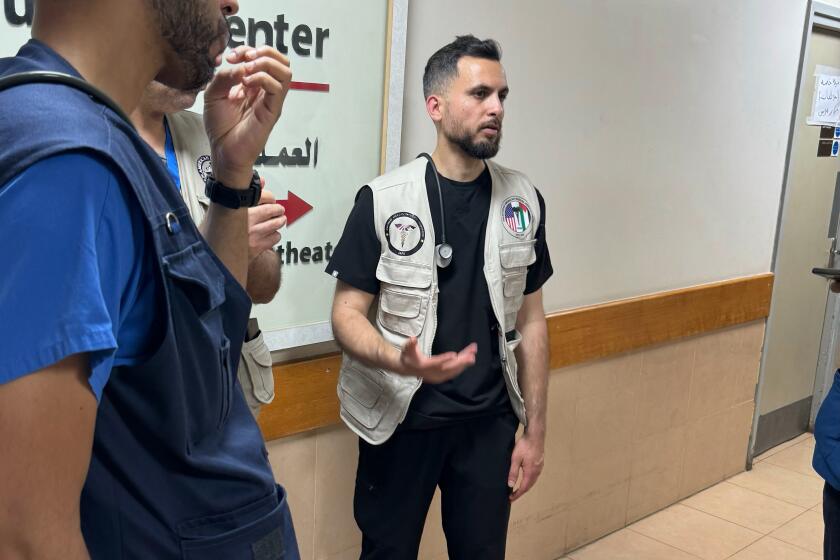Mexico’s Anti-Drug Force Slowly Rising From Ruins
Miguel, a tall young man with a pencil mustache, is a member of Mexico’s anti-drug force, an elite group in charge of fighting a deadly scourge. Here is how he spends his days: He takes his son to school. Then he watches some television. Maybe he visits his mother. He works out, eats, watches some more TV.
“This is like a vacation--a very long one,” the lanky cop says with a yawn.
Like most members of Mexico’s anti-drug agency, Miguel now fights nothing more than boredom. In a dramatic attempt to break with a history of corruption, Mexican authorities suspended him and the rest of the anti-drug forces last spring. Before they can return to work, the agents must pass exhaustive tests--from polygraphs to home inspections.
U.S. and Mexican authorities hope this will be the beginning of the nation’s first effective anti-drug force, something like the U.S. Drug Enforcement Administration.
But the building of Mexico’s DEA is agonizingly slow. And analysts say even this radical reform may not go far enough. Their criticisms raise a key point: How do you build an honest police force in a notoriously corrupt country?
“What you are talking about in my estimation is, at the very minimum, a 10-year program, and probably, realistically, a 20-year program,” DEA chief Thomas A. Constantine recently told reporters.
Mexico’s anti-drug program nearly collapsed in February when Gen. Jose de Jesus Gutierrez Rebollo--then this country’s crusty, balding drug czar--was arrested on charges that he worked for a trafficker who was flooding the United States with cocaine.
*
Jorge Madrazo Cuellar, a former human rights activist and now Mexico’s attorney general, swiftly suspended the entire anti-drug force with pay, declaring: “The changes must be radical.”
And they have been. Lately, every official in the anti-drug agency has taken psychological and medical exams. Examiners have pored over the agents’ credit card accounts, snooped around their homes, checked out their cars, tested their urine.
What they found was startling. Several officers were driving illegally imported cars. Some lied about their home addresses. Others were using drugs themselves.
Most of the anti-drug agents are still waiting to undergo their final exam, a lie-detector test. But pink slips will start going out in the next few weeks to those who have failed the exams--more than half so far, officials say.
“This is the only way to ensure honesty and a better work force,” said Jose Othon Ramirez, a Justice Ministry official in charge of the program.
While the scrutiny drags on, Mexico’s anti-drug force is a mere skeleton. Only 560 of the 2,200 members of the old drug-fighting institute are back on the job, at the new Special Prosecutor’s Office for Crimes Against Health, officials say.
The reorganization has slowed progress in the anti-drug fight, U.S. officials acknowledge. But they are hopeful. Working with agents who have been checked out, U.S. officials seized 2.7 tons of cocaine from a ship near Acapulco in August. “We’re definitely moving forward,” said one U.S. official.
*
To the U.S. government, reform of Mexico’s police is one of the most critical issues in the hemispheric fight against drugs. U.S. authorities note that, by working with trusted Colombian police, they dismantled one of the world’s most sophisticated drug businesses, the Cali cartel.
But U.S. authorities have never had that level of trust with the Mexicans. As drug trafficking has mushroomed here in recent years, they have watched helplessly. “If you give [intelligence] to 99% of the cops you work with [in Mexico], your case is blown,” said one former DEA official who worked with the Mexican authorities. “Major investigations go largely unfinished.”
To Miguel, the Mexican anti-drug cop, there are plenty of reasons why the police are so corrupt. There is, for one, his salary--about $500 a month. There is a lack of resources so severe that police sometimes must buy their own guns. Then there’s the chaos of a force in which police have traditionally risen depending on their contacts, not their training. Analysts say that since the Mexican government traditionally used the police to attack its political enemies, it never sought a professional, independent force. Only recently did the police get a civil service system.
With such problems, the Mexican system often seems designed to thwart honest cops.
Miguel’s former commander, who accompanied him to an interview in the bar of a five-star hotel, gave an example: Let’s say officers were ordered to tail a drug trafficker at a fancy hotel, said the commander, now retired. The police would know they would never be reimbursed for renting hotel rooms and other big expenses.
“So what does the policeman do? He talks to a minor drug trafficker and says, ‘Hey, give me money for this,’ ” said the former commander.
Miguel, the younger cop, leaned forward with a cynical smile. “There’s not even money for gas,” he said. He cited one example in which police were ordered to take three cars from Mexico City to the border, 1,100 miles away. They were given only $130 for fuel.
So what do you do? He jerked his thumb at the commander. “What he says,” he noted with a smile.
But Francisco Molina, a snowy-haired former prosecutor who headed Mexico’s anti-drug agency for eight months last year, was determined to change the system, he said. He extended the police training course from four to 16 months. He established exams so police could aspire to a higher rank.
He still made little headway against corruption. Finally, a consultant was hired to find out what was going wrong, he said. The consultant tested both longtime anti-drug cops and those still in the academy to see when officers went bad.
The results were stunning. Molina had thought brand-new cops would have idealism. In fact, they were every bit as eager to steal as the veterans. “They aspired to be corrupt police,” he said with a sigh. “They wanted to abuse their badges. They wanted to flash their guns. They wanted to wear jewelry. They wanted cars with tinted windows. They wanted to go to whorehouses and be treated well.”
Molina realized that the system had become so notoriously corrupt that it was attracting the corrupt. “There’s a psychological problem, a problem of values,” said the former anti-drug director, who was replaced when the attorney general was ousted in September 1996.
*
As if those results weren’t worrisome enough, Molina discovered that many young police were being sponsored by drug cartels. The traffickers apparently recruited the men, sent them to the police academy in Mexico City and bought them nice apartments and new cars.
Authorities face a near-impossible task in trying to change such police, Molina said. “They are trying to teach good manners to scorpions,” he said.
In reforming the police, Madrazo, this nation’s top law enforcement official, is concerned about salaries and training. But perhaps what Madrazo most fears is the law itself.
Last fall, Antonio Lozano Gracia, his predecessor, fired 800 officers. In many of these cases, the evidence of corruption was overwhelming. One dismissed officer had just bought a $1 million ranch, Molina says. Another owned an airline. A third was found to have 90 pounds of cocaine in his house, according to press reports.
But, ironically, the law was on the side of the corrupt police. They were not, as is legally required, given hearings before they were fired, and almost 600 of them have appealed their dismissals. So far, only a handful of officers have lost, while 207 have prevailed and most have returned to work.
Faced with that precedent, Madrazo has tried to proceed with his present reforms in a scrupulously legal, thorough fashion, officials say.
But it has not been easy. The current process, for example, has been delayed because there are few lie-detector experts in Mexico, where the test is practically unknown. The U.S. government recently agreed to assist Mexico by buying polygraph machines and training almost two dozen examiners in a program expected to cost more than $200,000.
Meantime, for the Mexicans involved, this is a life-or-death program. Previous examiners got death threats from officers they had tested. To prevent that, authorities are treating this process with the secrecy of a nuclear program.
Authorities say this scrutiny is just the first step in building the new Mexican DEA. They have asked Congress for the money to improve police salaries and benefits. The police academy course has been extended to two years.
Mexican officials also are accepting help from other countries. For example, almost 100 of the Mexican agents who have undergone the requisite testing have been sent to a four-week U.S. training course sponsored by the DEA and FBI. There, they have taken classes on interviewing and using informants. Some have practiced raids at Hogan’s Alley, a movie-set-like street with stores and a bank located at the FBI National Academy in Quantico, Va.
*
U.S. officials speak highly of Madrazo, who intends to make checks a standard, three-times-a-year practice for all agents.
The new program is already producing results, Constantine said, noting, “We’re seeing, since March, some special, select units that have been aggressive and honest . . . some decent people, who want to do the right thing.”
But the program’s success is still open to question. In past years, reforms of the police have started and stopped due to frequent changes at the top of the Justice Ministry, a political hot seat; there have been seven Mexican attorneys general in the past nine years.
And the anti-drug police are just one part of a criminal justice system long neglected or run along political lines. President Ernesto Zedillo has declared that he wants to establish justice institutions fit for a democracy.
But corrupt judges and prison guards continue to thwart his efforts.
“It’s a problem of institution-building,” said Jorge Chabat, a political scientist who studies drug trafficking. “It will be many years before we have a system of checks and balances.”
*
Times staff writer Ronald J. Ostrow in Washington contributed to this report.
More to Read
Start your day right
Sign up for Essential California for news, features and recommendations from the L.A. Times and beyond in your inbox six days a week.
You may occasionally receive promotional content from the Los Angeles Times.






